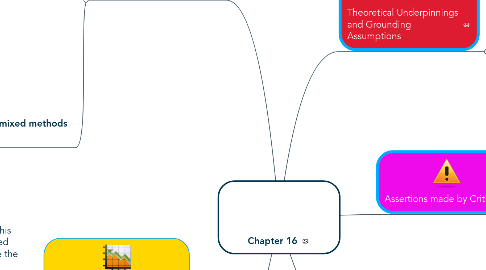
1. Approach to Data Collection and Analysis Two data types: QUAN= quantitative QUAL= qualitative
1.1. Convergent Design
1.1.1. Collect both QUAN and QUAL data at the same time and then merge the data and compare the results. If the results are conflicting then the researcher needs to explain these.
1.2. Explanatory Sequential Design
1.2.1. Collect QUAN then QUAL data in order to elaborate or explain the QUAN data. Priority is placed on the QUAN data
1.3. Exploratory Design
1.3.1. Collect QUAL then QUAN data in order to explore a topic with QUAL data and then explain it with the QUAN data. Priority is placed on the QUAL data.
1.4. Advanced Designs: Experimental, social justice, and multistage evaluation design.
1.4.1. Experimental: incorporates a mixed methods design into an experiment. Using two forms of data supplements information about the topic.
1.4.2. Social Justice: uses a mixed methods design within a framework that is aimed a a social justice issue. Frameworks used in mixed methods include feminist, racial, ethnic, disability, and LGTBQ perspectives. The researcher is calling for change.
1.4.3. Multistage Evaluation Design: mixed methods used to evaluate the impact or implementation of a program or project in multiple stages over time.
1.5. Steps to conducting mixed methods research
1.5.1. 1. Determine if a mixed methods study is feasible.
1.5.2. 2. Identify a rationale for mixed methods.
1.5.3. 3. Identify a data collection strategy and type of design.
1.5.4. 4. Develop quantitative, qualitative and mixed methods research questions.
1.5.5. 5.Collect quantitative and qualitative data.
1.5.6. 6. Analyze the data separately, concurrently, or both.
1.5.7. 7. Write the report as one, two, or multi- phase study.
2. Example Study: Igo, I. B., Kiewra, K. A., & Bruning, R. (2008). Individual differences and intervention flaws: A sequential explanatory study of college students' copy-and-paste not taking. Journal of Mixed Methods Research, 2(2), 149-168.
2.1. Purpose: "The purpose of this sequential explanatory mixed methods study is to explore the impact of different levels of copy-and-paste note-taking restriction have on learning from Web-based text" (p. 565)
2.2. Research Questions: "What effects do different levels of copy-and-paste note-taking restriction have on learning from Web-based text, and how are those effects manifested?" (p. 565)
3. Theoretical Underpinnings and Grounding Assumptions
3.1. Using both quantitative and qualitative methods provides a better understanding of the research question than using only one method.
3.2. Builds upon the strengths of both quantitative and qualitative data.
3.3. Can provide perspective in a study
3.4. Paradigms: Pragmatists & transformative however this methodology also fits with constructivists as well as many other paradigms.
3.5. History
3.5.1. 1930's-collecting multiple forms of data
3.5.2. 1959 Campbell & Fiske- multiple methods within a single study
3.5.3. 1973 Sieber- combined case studies with surveys
3.5.4. 1979 Jick- combined surveys, interviews, observations, and archival documents. Also illustrated the procedure for triangulation.

